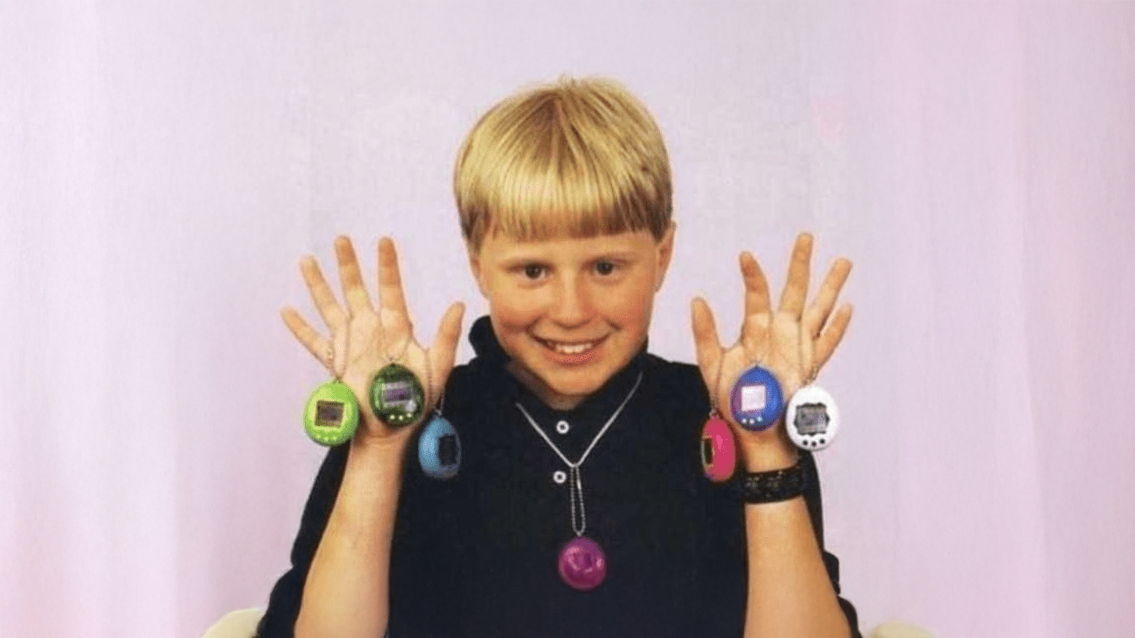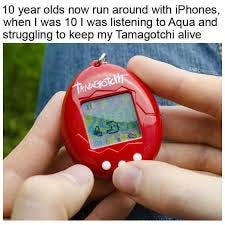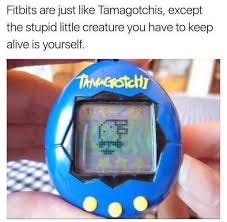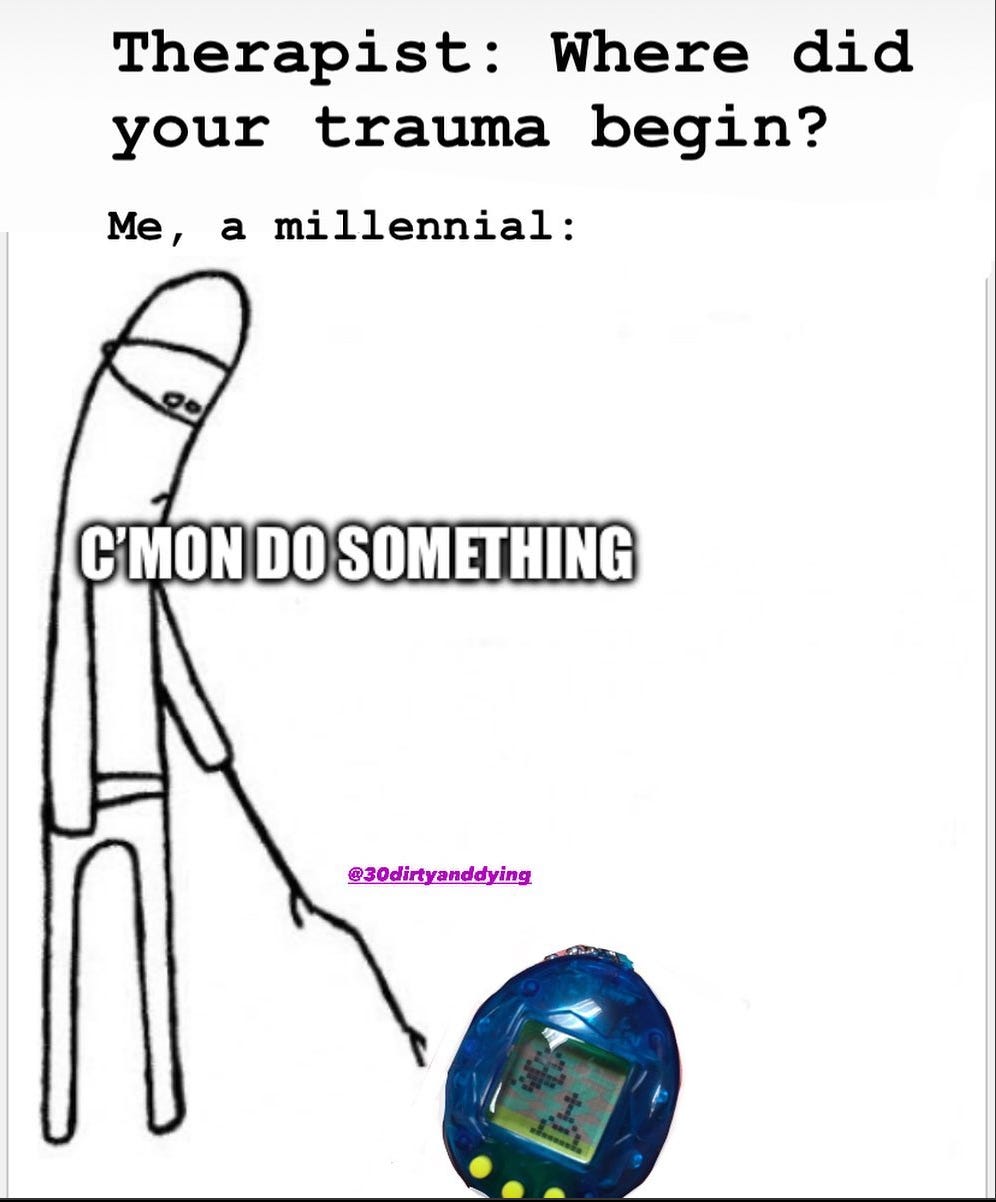🧵 How to Be Gaslit by a Digital Pet
The UX of Tamagotchi
It starts innocently enough: you name your Tamagotchi something cute (like “Bean” or “Lord Poopeth”), feed it a pixelated meal, and think, Wow, I’m crushing this pet ownership thing. Fast forward six hours and it’s screaming at you in the middle of math class, hungry, angry, covered in poop, and on the brink of death. You were never the owner. You were the owned.
It’s easy to think of the Tamagotchi as a nostalgic toy. But let’s admit something here: this wasn’t playtime. This was emotional hostage-taking with a lanyard clip.
Beep Beep, Bitch: You’re On Call Now
Tamagotchis didn’t come with pause buttons in the beginning. That meant once you pulled that little plastic tab and hatched your demon, you were locked in. You couldn’t just set it down and go vibe. No, you were now a full-time digital parent with a ticking death clock and three buttons of vague instructions.
You fed it. You played with it. You cleaned its poop. And if you were very lucky, it didn’t die on you while you were in gym class. It wasn’t just a game, but a relationship. The interface was clunky, the buttons barely responsive, and yet… you cared. You panicked when it beeped. You mourned when it “died.” You reset it anyway and started the whole cycle again.
Why?
Because it was designed that way.
When the Tamagotchi dropped in 1996, it low-key flipped the script on what we thought digital design could do. Created by Aki Maita and Yokoi Akihiro at Bandai, this tiny egg-shaped chaos gremlin didn’t need fancy graphics or a complicated setup. Just three buttons, a super basic screen, and and a speaker system that would become central to its psychological impact.
Designers even talked about it as a kind of “prosthetic presence” - a digital thing that became part of your life, your routine, your identity. And it worked. By 2010, over 76 million Tamagotchis had been sold around the world.
That sense of urgency wasn’t a glitch but the whole point of it. The fact that it could die within hours if neglected? That was a feature. It kept you on high alert, emotionally invested. And because it was portable, it came with you everywhere. That little plastic egg wasn’t just a game console but a full-time commitment. That’s kind of genius. And also slightly evil.
From a design standpoint, the Tamagotchi kind of nailed it when it came to making people actually care. If we look at it through Don Norman’s emotional design lens (yeah, we’re going there), the Tamagotchi hit all three levels. Viscerally, it was cute and simple—an egg you could carry around that beeped for your attention but didn’t overwhelm you with buttons or graphics. On the behavioral level, it gave you small, clear goals—feed, play, clean—that actually felt like they mattered. And then there’s the reflective layer, which is where things got deep: it made you think about responsibility, care, and even your relationship with digital things. It was a toy, sure, but it made you feel like a tiny pixel creature’s well-being was in your hands. Which, technically… it was.
The Tamagotchi Effect
The Tamagotchi didn’t just trick us into feeding it. It even made us feel things. Researchers gave this emotional chaos a name: the Tamagotchi effect. It’s the very human tendency to get attached to stuff that isn’t alive like robots, software, little beeping eggs that poop themselves. If it acts a little bit like it has feelings, we’ll treat it like it does.
Tamagotchis were designed to tap into that instinct. They smiled when they were happy, sulked when they were neglected, and bounced around when you played with them. It was just enough mimicry of a real pet to make you start seeing it as more than just a screen.
Even though Tamagotchis were early pioneers of emotional design, let’s not pretend they didn’t dabble in the dark arts of UX. Behind all that pixelated cuteness were some pretty manipulative design choices - ones that modern UX nerds would call dark patterns.
It created fake urgency on purpose. The idea was to make you feel like if you didn’t stop everything and respond right now, your pet would literally die. And a lot of kids believed that. Schools across the globe ended up banning Tamagotchis, not because they were violent or inappropriate, but because they were simply too effective at hijacking students’ attention.
The beeping notifications themselves became a kind of psychological trap. You couldn’t turn them off without risking your pet’s health—or worse, its life. That little chime, repetitive and heartbeat-like, created a sense of tethering that’s not so different from how we react to phone notifications today. Ignoring them wasn’t just hard. It felt wrong.
Even the gameplay mechanics leaned into manipulation eerily similar to the “freemium” traps we see in modern app design: short-term fixes that lead to more long-term work.
The Legacy of the Beep: Cute Toy or Early Warning?
Tamagotchi didn’t just teach us how to care for a virtual pet—it accidentally launched a decades-long debate about how tech messes with our heads. Virtual pets didn’t die, they just moved into your phone. Now they chill on your lock screen, pop up as widgets, or live in gamified self-care islands that low-key guilt you for not brushing your teeth. And the mechanics? Same old song: reward loops, urgency, emotional guilt, but now with better animation and push notifications. Sure, it looks cuter and maybe even “wellness”-branded, but the pressure’s still there. Feed the pet. Do your tasks. Be productive or it will cry.
Some apps, for example those that help you quit smoking by raising a virtual pet that thrives when you resist nicotine - can actually show that these systems can do good. But we have to ask: is it still good if the way it works is low-key manipulative? If you’re being nudged by code that knows exactly how to keep you hooked, is it motivation… or just fancy gaslighting?
There is hope, though. Some designers are exploring what’s called the “Tamagotchi Gesture” - a way to build emotionally engaging digital tools that don’t mess with your head. The idea? Create stuff that people care about, but don’t trap them with fake urgency or addictive loops. Sounds good, right?
But let’s not kid ourselves. In a world where engagement metrics rule and your app’s success depends on how long people stare at it, the line between caring and coercing is still super blurry.
So yeah—Tamagotchi lives on. Just maybe with better fonts and in-app purchases.













